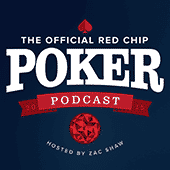When we suspect our opponent is capable of firing double barrel bluffs our way, how do we counter-attack? This week, we take a chapter out of Doug Hull’s classic strategy book Poker Plays You Can Use and analyze a hand to answer the question. Hull even illustrates alternate lines, alternate board card scenarios, and dives deep into the math behind his decisions.

Poker Plays You Can Use (book)
Poker Plays You Can Use (audio book)
Poker Plays You Can Use 2
Doug Hull: As you’re playing at the table, watch the other players. You’ll find certain players, the LAGs and the TAGs, fire a second barrel when good barreling cards come. Whenever you can predict what a player will do before they do it, they are exploitable.
Bluffing the bluffer is the next level of poker thinking. Raising this bluff is an excellent option, especially if you have a draw to back you up. The other reason the semi-bluff works is that it is rare at this level for a turn check raise to be anything but a strong made hand. This induces a lot more folds because we look so strong. This is how to play against players that are playing like us.
This happened at $2/$5 at the bike, in the hijack we have the hero who opens for $25 with 9, 10 suited in Hearts, we have a $600 dollar stack. In the cutoff, we have a lag who calls and covers everyone else in the hand. On the button we have a nit who calls with a $400 dollar stack, and in the small blind we have a weak player who calls with $550 in his stack.
We certainly do not like being out of position to the loose aggressive player. He tends to make our hands hard to play because he will bet or raise when he senses weakness. We expect the lag to not have complete garbage, but he does not necessarily need to be too strong here either. Most pairs, any two broad way cards, suited Aces, suited Kings and one or two gappers are all reasonable. He is capable of flat calling with premium hands if the mood suites him.
We are on the border of folding or opening in this hostile situation. The weak players in the blinds and the predictable nit on the button give us reason to open here. The flop comes down 3, 6, 8, with the 8 being of our suit. The rest of it is rainbow. There’s $57 in the pot. The unknown in the small blind checks, we check the loose aggressive in the cutoff makes it $35 into this $57 pot, the nit folds, it comes back to the small blind who also folds, and we’re going to call closing the action, “Heads up.”
Again, we have 9, 10 suited on this three, six, eight rainbow board. We have very little hand strength on this flop and terrible equity when called. Because of this, we did not like continuation betting into three opponents. However, after the lag bets, we can close the action heads up, with an inside straight draw, backdoor Hearts, two over cards and a board that has unlikely to have hit him either. We are getting great odds from his small bet. Having this relative position on the lag, has advantages as his predictable bet clears out the rest of the table. It’s now $127 in the pot and the rainbow is completed with a Queen of Spades. This gives us a double belly buster straight.
And, we check. The lag bets $75 into this $127 pot at which point we check raise nearly half of our stack to $225 of the $540 that we have. The lag folds. This is a very sneaky card for us. We have a well hidden double belly buster straight draw. It is a good barreling card for the lag. It is an over card and we have shown weakness and we are his only opponent. It is hard for us simply to call his bet because, we need to make a hand on the river to realize our showdown value. However, our hand has stealing value also. The stealing value combined with the showdown value makes this a profitable spot. His small bets and prior history of two barreling, gives us reason to try this move.
The range analysis leader in the alternative lines section applies here also. He does not likely have a strong hand, so we can push him out with a check raise. If he shoves over our check raise, it comes down to pot odds and our perception of his range. We would be getting 2.4 to 1 on the shove. If he has even an over pair like Ace, Ace. We need 4.5 to 1. If he only has an eight on this three, six, eight, Queen board. Then, we can barely squeak in a call since we need at least 2.14 to call and we’re getting 2.4.
If he flat calls and we miss the river, it is doubtful he called with anything that he would fold on the river for the small amount we have left. We got really lucky with the draw we picked up on the turn. Let us look at an alternative line and see what happens if we are less fortunate with the turn card. In this alternative line, the King of Clubs comes out giving backdoor clubs and not much else. The pot is $127, again we check. This time, the lag bets out $75 again, and we make the same check raise to $225 only now, we’ve only got a gutter ball straight draw.
The lag would likely fold again. He did this because when the villain bets out again on the turn, let’s look at his range. He called a late raise pre-flop and we had put him on a range like this. Any suited Ace, any suited King down to eights. Queen, 9 and better suited. Jack, 8 and better suited. 10, 7 and better suited. 9, 7 and suited. 8, 7 and suited. Pocket pairs 4’s and better. And then, any unsuited broad way cards and unsuited Aces down to Ace, 9. This is about 25% of all starting hands. This range only hits this flop about 20% of the time. Half those times it’s with an over pair. A third of the time it’s with just top pair. Sets and straight draws make up the rest.
Here are the hands that hit. We can see that it’s all the 8’s. So, Ace, 8 suited. King, 8 suited. Jack, 10, 9, 8 suited. 9, 7 suited. 8, 7 suited. The sets. 6’s and 8’s, and all the over pairs, 9’s through Aces. This is about 20% of what we thought he would play this way pre-flop. How many of these reduced hands like betting when the King of Clubs comes on the turn? Only about half of those. So now, we’re at 10% of the pre-flop range and it’s basically, the suited 8’s again in clubs, only. King, 8 suited. Aces, Kings, the 9, 7 suited. And, the sets 6’s and 8’s.
The point of looking at this is that, rarely does he have a hand here. Only 20% of his starting range hits. Only 50% of that 20% hits the turn too. So, only 10% of the time does he have a hand strong enough to bet here. It seems far more likely that he is just betting out because we showed weakness. This is not some nit that is out betting because he got lucky and hit a great hand. This is a guy who has shown a proclivity towards betting into weakness. That is why the check raise will work. Even if we did not have a draw to back it up.
What are we representing on this board? Nothing. Absolutely nothing. He will probably give us credit for a set that we played sneaky. This is a bluff that is pressuring a weak range while not particularly representing anything in particular. This kind of analysis shows that almost no card really helps him. We would likely check raise any card with similar prospects.
Let us look at a different alternative line. We checked the original turn and get in a check raise. What happens if the villain checks behind on the turn? Let’s look at an alternative line where we get a 7 of clubs on the river. There’s $127 in and we just made our nut straight. In this line, into that $127 pot, let’s bet $20 of our $540 stack. Now normally, if we hit one of our straight cards, we could just sell our hand for whatever we think we can get for it. A standard bet might be about $100 into this $127 pot, when we make it. We can also try this line, something strange. Bet one fifth of the pot, $20. What lag is going to fold to this small bet? It would prove that he had nothing. Calling is just not his style. He might convince himself that this strange little bet is a blocking bet.
If we’re making a blocking bet then, we would fold to a raise. In this book, we raise when we think someone will bet fold often, our small bet size telegraphs the intention to fold to a raise, among other players. Villain likes raising when other people show weakness. Give it a try. This is how we beat people that play like us. Also, the 7 might make him a tempting two pair if he had suited connectors, like 6, 7 or 7, 8. If he held this, his raise would very likely come giving us a chance to shove. What if in this alternative line where the Queen came on the turn, giving us that double gutter? We got a 4 of Diamonds instead, not making our straight. In this $127 pot, we’re going to bet out $175 and, the Villain’s likely going to fold.
If the turn checks through and we do not hit our made straight, we know that he bet the flop but then, he checked back the turn. From earlier analysis, we suspect that he has a very weak hand. He wants to get to a cheap showdown. A healthy donk over bet here really pressures his holdings. It appears as if we have one last chance for value and do not want to miss it. We are not representing anything in particular, but we do not need too. He will not need much of a story to fold his hand. He seems to only have a single pair, one beaten by a single Queen. He will fold pretty much everything here.
New hand. This semi-bluff requires courage and observation of patterns. While we have some showdown equity with our draw, this play is mostly about noticing that a player is willing to double barrel with error. Just as we might bluff raise a continuation bet, we are now bluff shoving a frequent two barreler. This happened at a $1/$2 game. Under the gun plus one, we have an unknown who limps. In mid position one, we have a loose passive who also limps. In MP two, we have a tag that raises it up to $12, and we are on the button with Ace, Jack suited. The under the gun limper folds and the loose passive calls. Stacks are effective at about $260.
The flop comes out 4, 7, 10 giving us backdoor Hearts with the 4. The pot is $41 and we’ve got two over cards, Ace, Jack of Hearts. The loose passive checks. The tag bets it out, $30 into this $41 pot and we’re going to call as a float. The loose passive folds and we are heads up in position against the tag. This all starts when he fires the first barrel on a flop, that does not really hold much for anyone. Certainly, he could do this legitimately with Jack, Jack plus and some good 10’s. More likely, he has two missed over cards. Some tenuous suited connectors. Or possibly, some low pairs that are now essentially a bluff.
There’s $101 in the pot on the turn, when the King of Spades comes in, giving backdoor spades with the 7 of spades from the flop. The tag bets $60 into this $101 pot. He started this streak with $270 and we’re going to shove with our Ace, Jack suited. The only real value hands that like this King are Aces, Kings, 10’s, King, 10 and flush draws.
Maybe, he was leading out with Ace, King, King, Queen, King, Jack on the flop too. This is a very small amount of his range. Imagine you were this tag and you were following the barreling plan with Ace, Queen. Ace, Jack, Queen, Jack, Jack, Jack. 8, 9 suited or 8, 8 on this 4, 7, 10, King board. Would you like to make a hero call on the chance that we were making a play? Exactly. We have just as empty of a range as him, but is harder to call a bet than it is to make one.

